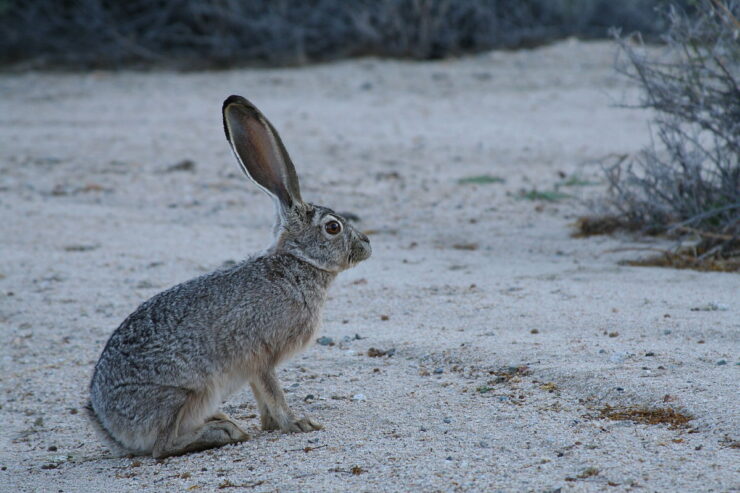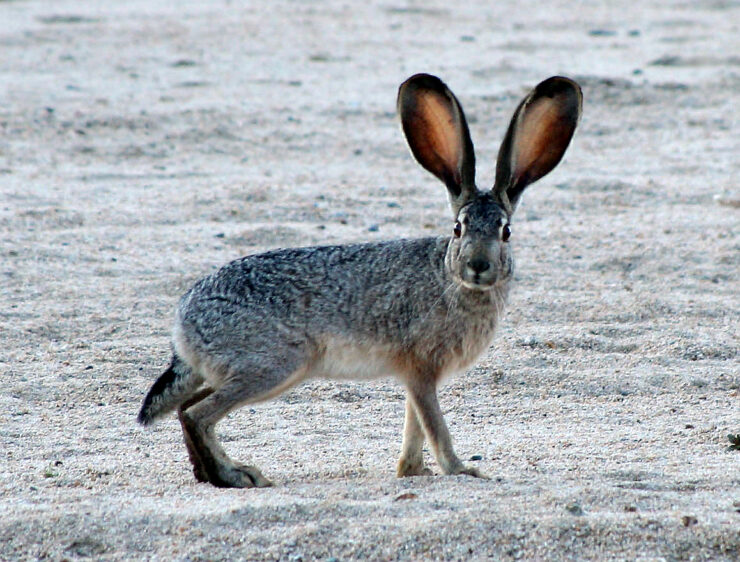When it comes to small game hunting there are three species of Jackrabbit of significance. The Black-tailed Jackrabbit, the White-tailed Jackrabbit and the Antelope Jackrabbit. Each will be discussed here separately. We will start with the Black-tailed Jackrabbit (Lepus californicus).
Hunting Tip: Hunting in a group or with a partner is a great way to target jack rabbits. One person walks around and flushes out the hares for the others to shoot at. Two way radios are a great way to keep in contact with other members of your hunting group.
The Black-tailed Jackrabbit is also known as the Desert Hare. It is a common hare found in Western USA and Mexico. It’s can be found at nearly all elevations ranging from sea level to up to 9000 feet. Like all jackrabbits, the Black-tailed Jackrabbit has the characteristic long ears, and long rear legs. Its fur is dark brownish grey peppered with black. Its ears are tipped with black, and it has a black stripe down its back. The tail is black above but white beneath.

The Black-tailed Jackrabbit is commonly seen on pasture and waste land during the day, though it is mostly nocturnal. They feed on cactus, sagebrush, mesquite, grasses, and crop plants. They drink little, deriving most of their water from food. Like most hares, Black-tailed Jackrabbits do not use burrows, but rest during the day in a scrape in the pasture called a form, relying on their acute hearing and speed to evade predators.
They are preyed upon by coyotes, foxes, bobcats, weasels and hawks. Unlike rabbits they are largely solitary animals. They will also thump the ground with their hind legs as an alarm signal.
Up to four litters may be produced in a year, with up to eight young in a litter. They are born in a form, above ground. Gestation is around 45 days and the young are active and relatively independent from birth, and their mothers only nurse them for a short time.
Black-tailed Jackrabbit
Black-tailed Jackrabbit populations are characterized by extreme “boom-bust” cycles. These cycles can be very localized: Jackrabbits may be plentiful in one valley and almost absent from an adjacent valley. Population crashes are mostly due to disease (especially Tularemia), although environmental factors such as food availability can also play a part. The high birthrate of the jackrabbit allows populations to recover quickly after a crash. These cycles also have a large effect on predator populations, causing similar population cycles in predators such as coyotes and hawks.
The high prevalence of disease and parasites in jackrabbits also affects human predation – many hunters will not gather the jackrabbits they shoot, and those that do are well advised to wear gloves while handling carcasses and to cook the meat thoroughly. Most hunting of jackrabbits is done for pest control or sport.
Whitetailed Jackrabbit
The Whitetailed Jackrabbit (Lepus townsendii) are found throughout west-central Canada, east to extreme southwest Ontario down into Wisconsin and across the continent to the Rocky Mountains with a southern limit in central California. There range in the southeast has been reduced from its historical range but elsewhere the population is not endangered and is actually spreading into more northerly climates.
White-tailed jackrabbits prefer open grasslands but thrive in pastures and fields. This species can also be found in forested areas up to high alpine tundra, they are commonly in elevations above 4000 meters.
The breeding season of white-tailed jackrabbits lasts from February to July. Each year females can produce one to four litters with each litter containing 1 to 11 offspring. The gestation period is commonly reported as about 42 days.
The young jackrabbits begin to forage at approximately 2 weeks of age and are fulled weaned at one month. Sexually maturity is reached by 7 or 8 months but breeding usually doesn’t occur until about the 11th month.
Whitetailed jackrabbits are strict herbivores. They feed on grasses, forbs, and shrubs in varying amounts. They are preyed upon by the same animals as the Blacktailed jackrabbit.
Whitetailed jackrabbits were a significant food source for early settlers of North America and continue to be a year round game animal. Their fur was once widely used in the commercial fur industry.
Antelope Jackrabbit
The Antelope Jackrabbit (Lepus alleni) is found primarily in the southwest United States and is most common in Arizona. Although the largest population is found in Arizona the species extends into New Mexico, southeastern California, and parts of northern Mexico.
The Antelope Jackrabbit is found in a variety of habitats. It can be found on grassy hills or plains to the deserts of the southwest. Jackrabbits are not uncommon in urban areas either, where they have adapted very well to human encroachment upon their habitat.
The Antelope Jackrabbit feeds mainly from evening to early morning. It is silent except for the usual distress cry and grunts. It does not dig or occupy burrows, but rather depends on its strong running skills when in danger.
Fresh grass is eaten after the two rainy seasons that take place each year, and mesquite and cacti are eaten in the dry seasons. The Antelope Jackrabbit rarely drinks water. It gets most of the moisture it needs from the desert plants it eats.
The Antelope Jackrabbit is regarded as a common non-game mammal in Arizona where it is often hunted as a pest because of its damage to crops.

